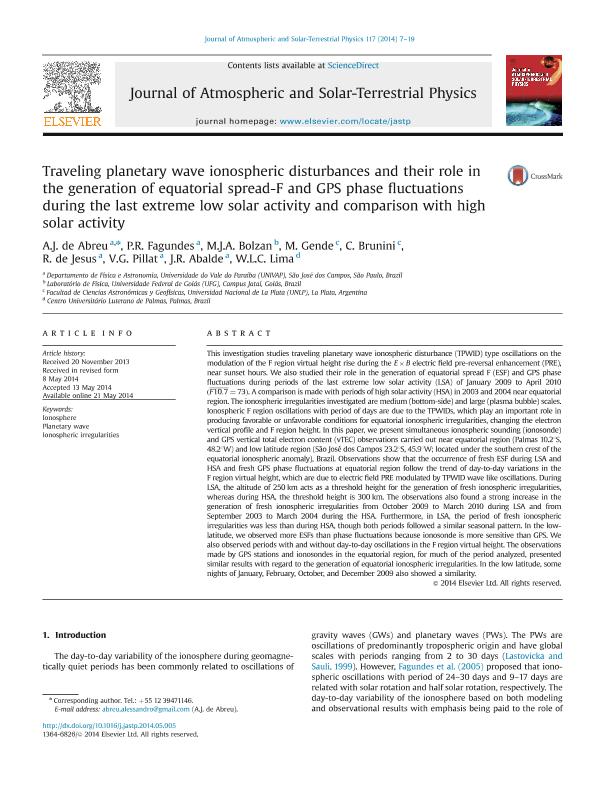Mostrar el registro sencillo del ítem
dc.contributor.author
de Abreu, A. J.
dc.contributor.author
Fagundes, P. R.
dc.contributor.author
Bolzan, M. J. A.
dc.contributor.author
Gende, Mauricio Alfredo

dc.contributor.author
Brunini, Claudio Antonio

dc.contributor.author
de Jesus, R.
dc.contributor.author
Pillat, V. G.
dc.contributor.author
Abalde, J. R.
dc.contributor.author
Lima, W. L. C.
dc.date.available
2017-06-06T15:33:31Z
dc.date.issued
2014-05
dc.identifier.citation
de Abreu, A. J.; Fagundes, P. R.; Bolzan, M. J. A.; Gende, Mauricio Alfredo; Brunini, Claudio Antonio; et al.; Traveling planetary wave ionospheric disturbances and their role in the generation of equatorial spread-F and GPS phase fluctuations during the last extreme low solar activity and comparison with high solar activity; Elsevier; Journal Of Atmospheric And Solar-terrestrial Physics; 117; 1; 5-2014; 7-19
dc.identifier.issn
1364-6826
dc.identifier.uri
http://hdl.handle.net/11336/17569
dc.description.abstract
This investigation studies traveling planetary wave ionospheric disturbance (TPWID) type oscillations on the modulation of the F region virtual height rise during the EB electric field pre-reversal enhancement (PRE), near sunset hours. We also studied their role in the generation of equatorial spread F (ESF) and GPS phase fluctuations during periods of the last extreme low solar activity (LSA) of January 2009 to April 2010 ðF10:7 ¼73Þ. A comparison ismadewith periods of high solar activity (HSA) in 2003 and 2004 near equatorial region. The ionospheric irregularities investigated are medium (bottom-side) and large (plasma bubble) scales. Ionospheric F region oscillations with period of days are due to the TPWIDs, which play an important role in producing favorable or unfavorable conditions for equatorial ionospheric irregularities, changing the electron vertical profile and F region height. In this paper, we present simultaneous ionospheric sounding (ionosonde) and GPS vertical total electron content (vTEC) observations carried out near equatorial region (Palmas 10.21S, 48.21W) and lowlatitude region (São José dos Campos 23.21S, 45.91W; located under the southern crest of the equatorial ionospheric anomaly), Brazil. Observations show that the occurrence of fresh ESF during LSA and HSA and fresh GPS phase fluctuations at equatorial region follow the trend of day-to-day variations in the F region virtual height, which are due to electric field PREmodulated by TPWID wave like oscillations. During LSA, the altitude of 250 km acts as a threshold height for the generation of fresh ionospheric irregularities, whereas during HSA, the threshold height is 300 km. The observations also found a strong increase in the generation of fresh ionospheric irregularities from October 2009 to March 2010 during LSA and from September 2003 to March 2004 during the HSA. Furthermore, in LSA, the period of fresh ionospheric irregularities was less than during HSA, though both periods followed a similar seasonal pattern. In the low- latitude, we observed more ESFs than phase fluctuations because ionosonde is more sensitive than GPS. We also observed periodswith and without day-to-day oscillations in the F region virtual height. The observations made by GPS stations and ionosondes in the equatorial region, for much of the period analyzed, presented similar results with regard to the generation of equatorial ionospheric irregularities. In the low latitude, some nights of January, February, October, and December 2009 also showed a similarity.
dc.format
application/pdf
dc.language.iso
eng
dc.publisher
Elsevier

dc.rights
info:eu-repo/semantics/openAccess
dc.rights.uri
https://creativecommons.org/licenses/by-nc-sa/2.5/ar/
dc.subject
Ionosphere
dc.subject
Planetary Wave
dc.subject
Ionospheric Irregularities
dc.subject.classification
Meteorología y Ciencias Atmosféricas

dc.subject.classification
Ciencias de la Tierra y relacionadas con el Medio Ambiente

dc.subject.classification
CIENCIAS NATURALES Y EXACTAS

dc.title
Traveling planetary wave ionospheric disturbances and their role in the generation of equatorial spread-F and GPS phase fluctuations during the last extreme low solar activity and comparison with high solar activity
dc.type
info:eu-repo/semantics/article
dc.type
info:ar-repo/semantics/artículo
dc.type
info:eu-repo/semantics/publishedVersion
dc.date.updated
2017-06-01T16:46:29Z
dc.journal.volume
117
dc.journal.number
1
dc.journal.pagination
7-19
dc.journal.pais
Países Bajos

dc.journal.ciudad
Amsterdam
dc.description.fil
Fil: de Abreu, A. J.. Universidade do Vale do Paraíba; Brasil
dc.description.fil
Fil: Fagundes, P. R.. Universidade do Vale do Paraíba; Brasil
dc.description.fil
Fil: Bolzan, M. J. A.. Universidade Federal de Goias; Brasil
dc.description.fil
Fil: Gende, Mauricio Alfredo. Universidad Nacional de La Plata; Argentina. Consejo Nacional de Investigaciones Científicas y Técnicas; Argentina
dc.description.fil
Fil: Brunini, Claudio Antonio. Universidad Nacional de La Plata; Argentina. Consejo Nacional de Investigaciones Científicas y Técnicas; Argentina
dc.description.fil
Fil: de Jesus, R.. Universidade do Vale do Paraíba; Brasil
dc.description.fil
Fil: Pillat, V. G.. Universidade do Vale do Paraíba; Brasil
dc.description.fil
Fil: Abalde, J. R.. Universidade do Vale do Paraíba; Brasil
dc.description.fil
Fil: Lima, W. L. C.. Centro Universitário Luterano de Palmas; Brasil
dc.journal.title
Journal Of Atmospheric And Solar-terrestrial Physics

dc.relation.alternativeid
info:eu-repo/semantics/altIdentifier/url/http://www.sciencedirect.com/science/article/pii/S1364682614000972
dc.relation.alternativeid
info:eu-repo/semantics/altIdentifier/doi/http://dx.doi.org/10.1016/j.jastp.2014.05.005
Archivos asociados
